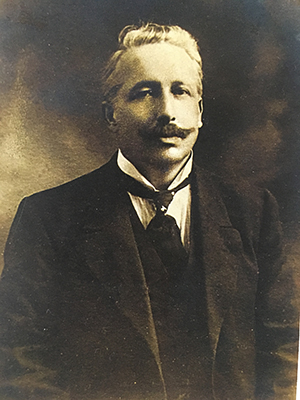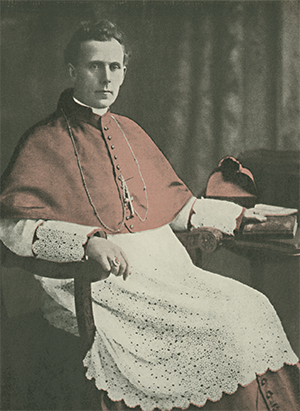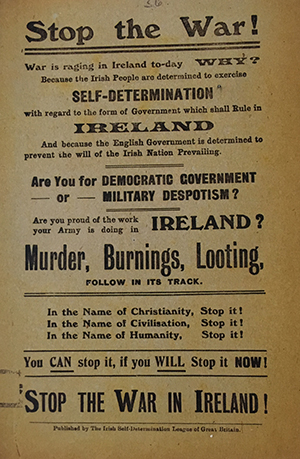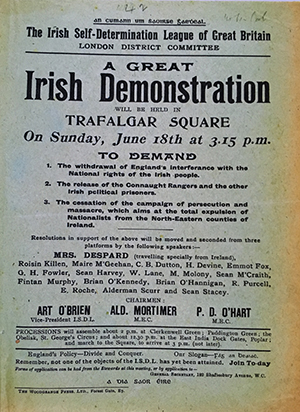A mixing of social and national aspirations
Published in Features, Issue 6 (November/December 2019), Volume 27The Irish Self-Determination League of Great Britain (ISDL), 1919–31.
By Pádraig Manning

Above: Art O’Brien, co-vice-president of the ISDL but in fact its key organiser. (NLI)
This year marks the centenary of the establishment of the Irish Self-Determination League of Great Britain (ISDL), a nationalist diaspora organisation founded in 1919 and formally disbanded in 1931. Despite claiming to have been ‘the greatest Irish-Ireland organisation [Great Britain] has ever known’, the League has received limited attention from historians. Its origins can be traced back to the fund-raising efforts of Britain’s Irish diaspora in response to the 1916 Rising, but it was not until 30 March 1919 that the ISDL was officially established in Manchester at the request of Sinn Féin president Éamon de Valera.
38,726 members at its height
Branches surfaced across England and Wales, with large memberships developing in areas with significant Irish diaspora communities, including Liverpool, London and Tyneside. The League’s central executive council featured Liverpool’s P.J. Kelly as president and Art O’Brien of London as co-vice-president, although it was the latter who was the ISDL’s key organiser. The League’s constitution was drawn up and its objectives were defined as:
‘To band together the Irish residents of Great Britain, in order that they shall as a body support their compatriots in Ireland, and use every means in their power to secure the application of the principle of self-determination for Ireland and the recognition of the Irish Republic … and … to render all and every assistance to any Irish subject imprisoned in Great Britain or Ireland for political offences, and to do all other acts which will further the cause of an independent Irish Republic.’
By the end of 1919, 54 branches were functioning across England and Wales, with a total membership of 3,823. By March 1920 these figures had increased to 98 branches and 9,017 members. Membership rates reached their peak in March 1921, during which the ISDL recorded 38,726 members throughout England and Wales. The ISDL experienced a decline in membership and activity after the signing of the Anglo-Irish Treaty in December 1921, owing in part to divisions catalysed by the Treaty but also as a result of increasing levels of unemployment and growing tensions between the League and the Free State government. These tensions culminated in the deportation of dozens of ISDL activists to Ireland in 1923 and the imprisonment of O’Brien and Seán McGrath, the ISDL’s general secretary, in Brixton Prison for eighteen months.
Campaigned on behalf of Archbishop Daniel Mannix
The League operated throughout the height of the Irish War of Independence, distributing propaganda, organising a series of large gatherings across England and Wales, collecting money for various Irish causes and selling bonds for the Dáil Loan, the revolutionary government in Dublin’s fund-raising scheme. One of the League’s most well-documented endeavours was its campaign on behalf of the Cork-born archbishop of Melbourne, Daniel Mannix, who was prohibited from landing in Ireland or Britain under the Defence of the Realm Act (DORA) in 1920. In November 1919 the ISDL mobilised a crowd of 15,000 in Liverpool, filled London’s Albert Hall in February 1920 for an event that included speeches from Arthur Griffith and Eoin MacNeill, and brought thousands onto the streets of Bolton, Bradford, London, Manchester and Tyneside in April 1920 in a show of support for Irish hunger strikers in Wormwood Scrubs prison. In November 1921 the League once again filled the Albert Hall to greet the Irish delegation that had travelled to London for peace talks. In addition, the League had a significant social and cultural dimension, assisting Britain’s Irish diaspora with legal and employment issues and promoting cultural events ranging from Irish language and history classes to céilithe and Gaelic games.
The ISDL’s membership was strictly confined to the Irish diaspora, with its constitution declaring that members were required to be ‘of Irish birth, or descent, resident in Britain’. As was explained to one ISDL hopeful in July 1919, restrictive membership was deemed necessary, as previous Irish societies in Britain had been weakened by the introduction of English members; O’Brien suggested that English sympathisers should instead create a league of their own dedicated to the cause of Irish self-determination. A number of individuals were in favour of relaxing this rule, but membership remained limited to the Irish diaspora for the duration of the League’s existence.

Above: The League campaigned on behalf of Archbishop Daniel Mannix of Melbourne, who was prohibited from landing in Ireland or Britain under the Defence of the Realm Act (DORA) in 1920.
Class make-up
Unfortunately, the ISDL left no comprehensive list of its members, but a census of individuals involved with the organisation undertaken by its executive in October 1921 yields valuable information regarding its demographic make-up. According to Gilbert Barrington, secretary of the League’s Tyneside branch, ISDL members in Tyneside were ‘usually the more recent immigrants’ and tended not to be ‘miners or unskilled men’. Instead, he suggested that they were primarily drawn from ‘the artisans, semi-skilled men, small tradesmen, and a few teachers and better-off business people’, maintaining that the most educated members of the diaspora were most active.
While this may have been true of Tyneside, ISDL census forms suggest that it was not the case across Britain. No Tyneside census forms exist, but the nearby Mid-Durham branch’s records present a sample of sixteen members, two of whom were female. One of these women was a teacher, while the other included no details of employment. The male members were primarily engaged in unskilled labour. Seven of the fourteen men were miners, three were general labourers, and the remaining four included a boiler-minder, a coal heaver, a painter and a postman. Similar trends held true across Britain and, overall, comparison of the census forms suggests that members shared a number of common characteristics, tending to be young, engaged in working-class occupations and disproportionately male.
Female involvement
Notwithstanding the discrepancy between male and female membership figures, women played a fundamental role in ISDL activities. While the Irish Exile, the ISDL’s official organ, pointed to the suffering of Irish women to emphasise the extent of British oppression in Ireland, female members of the Irish community in Britain were also highly active among the League’s ranks. The ISDL’s Southwark branch in London reported that, ‘as usual in Irish affairs, the women are the hardest workers and the keenest enthusiasts’. Furthermore, the League’s Blackpool branch noted that ‘thanks are notably due to the young and patriotic ladies of the branch’, and Barrington singled out a number of women for praise, including Martha Larkin, Theresa Mason and Frances Brennan and her sisters, all of whom played a prominent role in the ISDL’s activities in Tyneside.
Evidently, female participation was significant among the ISDL’s rank and file, and the events organised often included appearances from the Irish Revolution’s leading female figures, including Constance Markiewicz, Hanna Sheehy-Skeffington, Mary MacSwiney, Maude Gonne and Charlotte Despard. The League’s London branches frequently held meetings at the Minerva Café on High Holborn, a venue opened by the Women’s Freedom League during the war and primarily used by suffragettes, which further demonstrates the invaluable role played by women in the ISDL’s undertakings.

Above: An ISDL handbill distributed during British Labour’s ‘Hands Off Ireland’ campaign in 1921. (NLI)
Local British politics
The ISDL’s constitution also declared that ‘no Branch or District Committee shall at any time take any action in regard to or any part in English politics’. Some observers were critical of this approach, arguing that through their non-participation in English politics League members were, in effect, ‘[throwing] away the weapon of [their] citizenship’. Charles Diamond, editor of the Catholic Herald, consistently criticised the League’s refusal to endorse the Labour Party, and in May 1919 the following appeared in Diamond’s newspaper:
‘As one who strongly supports the policy of Sinn Féin, I am quite in favour of abstention from the House of Parliament on the part of the Home Parliament. I view, however, with great disfavour the abstention of the Irish in Britain from the English political arena. I feel that the [ISDL] should make its absence felt by its presence—that is to say that, by its presence in the political arena, it should impress on English Labour its absence of support should English Labour fail to pledge itself to the principle of self-determination for Ireland.’

Above: An ISDL handbill announcing ‘A Great Irish Demonstration’ in Trafalgar Square on 18 June 1922 [1921? ck]. (NLI)
That said, the ISDL reported that meetings also ‘draw an audience of English people’ and that ‘members will come into contact with many English people in the course of their work’. In 1919 O’Brien reported that callers at the ISDL office included many English individuals, and the League distributed its literature among the native population, recording the names and addresses of sympathetic Britons. This allowed the Dáil publicity department to place their names on the Irish Bulletin’s mailing list. Furthermore, the ISDL developed a close relationship with Britain’s Indian and Egyptian diaspora, who were likewise calling for national self-determination.

Above: A.A. Purcell—president of the national committee of the ‘Hands Off Russia’ campaign, founded by the British Socialist Party and other Marxist groups in January 1919—was also active in the ISDL.
Despite its refusal to engage with the British political process and to admit non-Irish members, ISDL activities were inextricably linked to mainstream British political developments, particularly the affairs of the Labour movement, with Barrington suggesting that the ISDL represented ‘a mixing of social and national aspirations’. In the north of England the development of the ISDL was grounded in the tradition of Chartism, radicalism and class struggle. For example, prior to the establishment of ISDL branches in Tyneside, class issues took precedence, with ‘very many Irish … involved in English politics, nearly all for Labour’. Nationalist activists in the area had originally formed an Irish Labour Party which sought to ‘build up an Irish influence inside the British Labour Party’, and it was not until several members became sceptical of this movement’s preoccupation with English interests that the first Tyneside ISDL branch was formed in South Shields in early 1920.
The relationship between the ISDL and the Labour movement was recognised by Basil Thomson of the Home Office, who expressed concern about the possibility of an ISDL–Labour alliance. These fears were rationalised by the fact that Kelly, the ISDL’s president until 1922, had originally risen to prominence through local trade union politics in Liverpool. Kelly’s Labour activities did not come to a halt during his involvement with the ISDL; he continued to make efforts to link Irish nationalism and British labourism. For example, in April 1920 he called for strike action among Liverpool’s dockers in support of Sinn Féin hunger strikers being held without trial in Wormwood Scrubs and Mountjoy prisons. While his call gained some traction among the city’s dockers, the venture ultimately failed, with Liverpool’s Labour and trade union leaders refusing to endorse the strike.
Many more individuals were closely affiliated with both the ISDL and British Labour. In the October 1919 local council elections, a number of ISDL organisers were elected on the Labour Party ticket, including League members from Battersea, Blackheath, Charlton and Greenwich, Limehouse, Poplar, Stepney and Woolwich. Furthermore, the ‘Hands Off Russia’ campaign, founded by the British Socialist Party and other Marxist groups in January 1919, had A.A. Purcell as president of its national committee and William Peyton Coates as its secretary, both of whom were also active within the ISDL. John Scurr was a Labour councillor involved with the Daily Herald and president of the League’s Poplar branch. Along with four other Poplar councillors, all of whom were involved with the ISDL, Scurr was jailed in 1921 for supporting a council default on local rates and spoke at the League’s Trafalgar Square demonstration in February 1922, which reflects his dual allegiance to both Labour and Irish causes. Moreover, in 1921 the ISDL’s London branches participated in a May Day demonstration in Hyde Park, during which the League set up two platforms ‘right in the heart of the … Labour demonstration’ and attracted ‘mostly Irish, but there was a fair sprinkling of British trade unionists’ too, demonstrating the extent to which the ISDL’s mobilisation of the Irish diaspora was aided by its grass-roots associations with the Labour movement.
Tension also existed between Irish self-determinationists and Labour activists, with the ISDL accusing British political organisations of ‘[using] the Irish population for their own purposes’ and Labour speakers sometimes experiencing heckling at ISDL events. Furthermore, the ISDL was reluctant to link itself with radical British organisations in any official capacity. For example, in correspondence with a London communist, O’Brien stated that although there are ‘those who happen to be members of the [ISDL] and are members of the Communist Party’, there was no direct correlation between membership of the two groups. Others within the ISDL leadership took a more cynical view of both the British Labour Party and British workers, demonstrating the existence of a close yet uneasy relationship between diasporic nationalism and labourism throughout the years of the Irish Revolution.
Pádraig Manning holds an MSc. from the London School of Economics and Political Science (LSE).
FURTHER READING
G. Bell, Hesitant comrades: the Irish Revolution and the British Labour Movement (London, 2016).
D. Foxton, Revolutionary lawyers: Sinn Féin and crown courts in Ireland and Britain 1916–23 (Dublin, 2008).
D. Gannon, ‘The Irish Revolution in Great Britain’, in J. Crowley, D. Ó Drisceoil, M. Murphy & J. Borgonovo (eds), Atlas of the Irish Revolution (Cork, 2017).
K. Inoue, ‘Dáil propaganda and the Irish Self-Determination League of Great Britain during the Anglo-Irish War’, Irish Studies Review 6 (1) (1998).
















